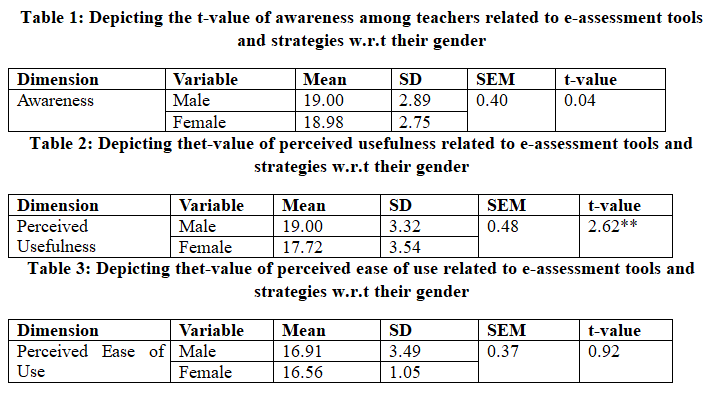PERCEIVED POTENTIAL OF E-ASSESSMENT STRATEGIES: AN INNOVATIVE PEDAGOGICAL APPROACH
Abstract
COVID-19 is a pandemic threat through which the entire planet is affected, and at the same time, everything went through tremendous changes, including education. E-learning has become the sole method of knowledge transfer, even in developing countries, and e-assessment has become more and more crucial in this digital transformation of education. To fully utilize its potential to improve students’ learning demands, however, it must be understood how deeply and how far it has ingrained itself in teachers' minds. This paper aims to examine the perception of teachers regarding e-assessment strategies in the teaching-learning process as well as the challenges they faced while using e-assessment techniques. For this purpose, the researchers employed a self-constructed tool on a sample of 200 school teachers who are presently working in different institutions across the country. By using appropriate statistical techniques, the findings of the present research work discovered a significant difference in perceived usefulness, compatibility, self-efficacy, and resource facilitation as four important domains of e-assessmentwith respect to the gender of teachers at the school level, it is also observed that no significant difference among teachers as per their gender in awareness, and perceived ease of use and ITsupportsthe domain of e-assessment.On the basis of the findings, it is recommended that there is a need for such training programs and capacity-buildingprograms for school teachers that will increase the self-efficacy and compatibility among them regarding the effective usage of e-assessment and evaluation strategies to create an optimal learning environment in the classroom.
Downloads
References
Abdelkader, A., Boumiza, D. S., & Braham, R. (2014). E-assessment System Based on IMS QTI for the Arabic Grammar. International Journal of Advanced Computer Science and Singh Nathial, D. M. (2012). ANALYZING THE CREDIT BASED SYSTEM IN PHYSICAL EDUCATION. International Journal of Behavioral Social and Movement Sciences, 1(3), 172–176. Retrieved from https://ijobsms.org/index.php/ijobsms/article/view/37
SHARMA, N. P., & SINGH, M. (2014). SENIOR AGE GROUP RELATIVE EXERCISES AND IMPACT ON THEIR LIFESTYLE. International Journal of Behavioral Social and Movement Sciences, 3(04), 78–82. Retrieved from https://ijobsms.org/index.php/ijobsms/article/view/246
CHAND PURI, P., MISHRA, P., JHAJHARIA, B., & SINGH, M. (2014). COORDINATIVE ABILITIES OF VOLLEYBALL IN DIFFERENT AGE GROUPS: A COMPARATIVE STUDY. International Journal of Behavioral Social and Movement Sciences, 3(3), 56–68. Retrieved from https://ijobsms.org/index.php/ijobsms/article/view/228
Applications, 5(10).
Agarwala, P., Phadke, S., & Tilak, P. (2021). Online Exams During COVID-19: Teacher's Perspective. Turkish Online Journal of Qualitative Inquiry, 12(6), 5050-5056.
Alruwais, N., Wills, G., & Wald, M. (2016). Identifying factors that affect the acceptance and use of E-assessment by academics in Saudi Universities. International E-Journal of Advances in Education, 2(4), 132-140.
Binkley, M., Erstad, O., Herman, J., Raizen, S., Ripley, M., Miller-Ricci, M., & Rumble, M. (2012). Defining twenty-first century skills. Assessment and teaching of 21st century skills, 17-66.
Bowden, J., Dall’Alba, G., Martin, E., Laurillard, D., Marton, F., Masters, G., ... & Walsh, E. (1992). Displacement, velocity, and frames of reference: Phenomenographic studies of students’ understanding and some implications for teaching and assessment. American Journal of Physics, 60(3), 262-269.
Buzzetto-More, N. A., & Pinhey, K. (2007). Evaluating e-learning for quality assurance. Advanced Principles of Effective e-Learning, 181.
Cayton-Hodges, G. A., Feng, G., & Pan, X. (2015). Tablet-based math assessment: What can we learn from math apps? Journal of Educational Technology & Society, 18(2), 3-20.
Crews, T. B., & Curtis, D. F. (2011). Online course evaluations: Faculty perspective and strategies for improved response rates. Assessment & Evaluation in Higher Education, 36(7), 865-878.
Daly, C., Pachler, N., Mor, Y., & Mellar, H. (2010). Exploring formative e‐assessment: using case stories and design patterns. Assessment & Evaluation in Higher Education, 35(5), 619-636.
Gilbert, Lester, Denise Whitelock, and Veronica Gale. "Synthesis report on assessment and feedback with technology enhancement." (2011).
Koneru, I. (2017). Exploring Moodle functionality for managing Open Distance Learning e-assessments. Turkish Online Journal of Distance Education, 18(4), 129-141.
Marton, F., Hounsell, D., & Entwistle, N. J. (Eds.). (1997). The experience of learning: Implications for teaching and studying in higher education. Scottish Academic Press.
Nikou, S. A., & Economides, A. A. (2018). Mobile-based assessment: A literature review of publications in major referred journals from 2009 to 2018. Computers & Education, 125, 101-119.
Ridgway, J., McCusker, S., & Pead, D. (2004). Literature review of e-assessment. Futurelab.
Rolim, C., & Isaias, P. (2019). Examining the use of e‐assessment in higher education: teachers and students’ viewpoints. British Journal of Educational Technology, 50(4), 1785-1800.
Sorensen, E. (2013). Implementation and student perceptions of e-assessment in a Chemical Engineering module. European Journal of Engineering Education, 38(2), 172-185.
Singh, A., & Singh , D. M. (2013). PROMOTION OF RESEARCH CULTURE –ENHANCING QUALITY IN HIGHER EDUCATION. International Journal of Behavioral Social and Movement Sciences, 2(2), 202–208. Retrieved from https://ijobsms.org/index.php/ijobsms/article/view/152
SINGH, M., & SINGH SIDHU, A. (2016). A COMPARATIVE STUDY OF BODY COMPOSITION AND RELATIVE HEALTH STATUS AMONG RESIDENT AND NON-RESIDENT STUDENTS IN DIFFERENT SCHOOLS OF J&K. International Journal of Behavioral Social and Movement Sciences, 5(3), 08–13. Retrieved from https://ijobsms.org/index.php/ijobsms/article/view/320
Spector, J. M., Ifenthaler, D., Sampson, D., Yang, J. L., Mukama, E., Warusavitarana, A., ... & Gibson, D. C. (2016). Technology enhanced formative assessment for 21st century learning.
Stödberg, U. (2012). A research review of e-assessment. Assessment & Evaluation in Higher Education, 37(5), 591-604.
St‐Onge, C., Ouellet, K., Lakhal, S., Dubé, T., & Marceau, M. (2022). COVID‐19 as the tipping point for integrating e‐assessment in higher education practices. British Journal of Educational Technology, 53(2), 349-366.https://doi.org/10.1111/bjet.13169
Teplytskyi, O., Teplytskyi, I., Semerikov, S., & Soloviev, V. (2019). Training future teachers in natural sciences and mathematics by means of computer simulation: a social constructivist approach. arXiv preprint arXiv:1907.09726.

Copyright (c) 2023 Parinka Sharma, Seema Rani Thappa, Jyoti Narayan Baliya

This work is licensed under a Creative Commons Attribution 4.0 International License.














